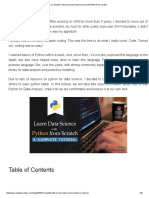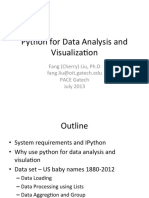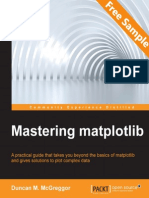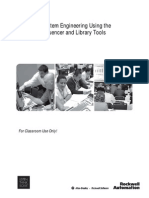12 Useful Pandas Techniques in Python For Data Manipulation PDF
Uploaded by
Teodor von Burg12 Useful Pandas Techniques in Python For Data Manipulation PDF
Uploaded by
Teodor von Burg9/6/2016
12UsefulPandasTechniquesinPythonforDataManipulation
Introduction
Python is fast becoming the preferred language for data scientists and for good reasons. It
provides the larger ecosystem of a programming language and the depth of good scientific
computationlibraries.IfyouarestartingtolearnPython,havealookatlearningpathonPython.
Among its scientific computation libraries, I found Pandas to be the most useful for data science
operations. Pandas, along with Scikitlearn provides almost the entire stack needed by a data
scientist. This article focuses on providing 12 ways for data manipulation in Python. Ive also
sharedsometips&trickswhichwillallowyoutoworkfaster.
Iwouldrecommendthatyoulookatthecodesfordataexplorationbeforegoingahead.Tohelpyou
understandbetter,Ivetakenadatasettoperformtheseoperationsandmanipulations.
DataSet:IveusedthedatasetofLoanPredictionproblem.Downloadthedatasetandgetstarted.
Letsgetstarted
IllstartbyimportingmodulesandloadingthedatasetintoPythonenvironment:
http://www.analyticsvidhya.com/blog/2016/01/12pandastechniquespythondatamanipulation/
1/13
9/6/2016
12UsefulPandasTechniquesinPythonforDataManipulation
importpandasaspd
importnumpyasnp
data=pd.read_csv("train.csv",index_col="Loan_ID")
#1BooleanIndexing
What do you do, if you want to filter values of a column based on conditions from another set of
columns?Forinstance,wewantalistofallfemaleswhoarenotgraduateandgotaloan.Boolean
indexingcanhelphere.Youcanusethefollowingcode:
data.loc[(data["Gender"]=="Female")&(data["Education"]=="NotGraduate")&(data["Loan_Status"]=
="Y"),["Gender","Education","Loan_Status"]]
ReadMore:PandasSelectingandIndexing
http://www.analyticsvidhya.com/blog/2016/01/12pandastechniquespythondatamanipulation/
2/13
9/6/2016
12UsefulPandasTechniquesinPythonforDataManipulation
#2ApplyFunction
It is one of the commonly used functions for playing with data and creating new
variables. Apply returns some value after passing each row/column of a data frame with some
function.Thefunctioncanbebothdefaultoruserdefined.Forinstance,hereitcanbeusedtofind
the#missingvaluesineachrowandcolumn.
#Createanewfunction:
defnum_missing(x):
returnsum(x.isnull())
#Applyingpercolumn:
print"Missingvaluespercolumn:"
printdata.apply(num_missing,axis=0)#axis=0definesthatfunctionistobeappliedoneachcolu
mn
#Applyingperrow:
print"\nMissingvaluesperrow:"
printdata.apply(num_missing,axis=1).head()#axis=1definesthatfunctionistobeappliedonea
chrow
http://www.analyticsvidhya.com/blog/2016/01/12pandastechniquespythondatamanipulation/
3/13
9/6/2016
12UsefulPandasTechniquesinPythonforDataManipulation
Thuswegetthedesiredresult.
Note:head()functionisusedinsecondoutputbecauseitcontainsmanyrows.
ReadMore:PandasReference(apply)
#3Imputingmissingfiles
fillna()doesitinonego.Itisusedforupdatingmissingvalueswiththeoverallmean/mode/median
ofthecolumn.LetsimputetheGender,MarriedandSelf_Employedcolumnswiththeirrespective
modes.
#Firstweimportafunctiontodeterminethemode
fromscipy.statsimportmode
mode(data['Gender'])
Output:ModeResult(mode=array([Male],dtype=object),count=array([489]))
Thisreturnsbothmodeandcount.Rememberthatmodecanbeanarrayastherecanbemultiple
http://www.analyticsvidhya.com/blog/2016/01/12pandastechniquespythondatamanipulation/
4/13
9/6/2016
12UsefulPandasTechniquesinPythonforDataManipulation
valueswithhighfrequency.Wewilltakethefirstonebydefaultalwaysusing:
mode(data['Gender']).mode[0]
Nowwecanfillthemissingvaluesandcheckusingtechnique#2.
#Imputethevalues:
data['Gender'].fillna(mode(data['Gender']).mode[0],inplace=True)
data['Married'].fillna(mode(data['Married']).mode[0],inplace=True)
data['Self_Employed'].fillna(mode(data['Self_Employed']).mode[0],inplace=True)
#Nowcheckthe#missingvaluesagaintoconfirm:
printdata.apply(num_missing,axis=0)
Hence, it is confirmed that missing values are imputed. Please note that this is the most primitive
form of imputation. Other sophisticated techniques include modeling the missing values, using
groupedaverages(mean/mode/median).Illcoverthatpartinmynextarticles.
ReadMore:PandasReference(fillna)
http://www.analyticsvidhya.com/blog/2016/01/12pandastechniquespythondatamanipulation/
5/13
9/6/2016
12UsefulPandasTechniquesinPythonforDataManipulation
#4PivotTable
PandascanbeusedtocreateMSExcelstylepivottables.Forinstance,inthiscase,akeycolumnis
LoanAmount which has missing values. We can impute it using mean amount of each Gender,
MarriedandSelf_Employedgroup.ThemeanLoanAmountofeachgroupcanbedeterminedas:
#Determinepivottable
impute_grps=data.pivot_table(values=["LoanAmount"],index=["Gender","Married","Self_Employed"],
aggfunc=np.mean)
printimpute_grps
More:PandasReference(PivotTable)
#5MultiIndexing
Ifyounoticetheoutputofstep#3,ithasastrangeproperty.Eachindexismadeupofacombination
of3values.ThisiscalledMultiIndexing.Ithelpsinperformingoperationsreallyfast.
Continuingtheexamplefrom#3,wehavethevaluesforeachgroupbuttheyhavenotbeenimputed.
Thiscanbedoneusingthevarioustechniqueslearnedtillnow.
#iterateonlythroughrowswithmissingLoanAmount
fori,rowindata.loc[data['LoanAmount'].isnull(),:].iterrows():
http://www.analyticsvidhya.com/blog/2016/01/12pandastechniquespythondatamanipulation/
6/13
9/6/2016
12UsefulPandasTechniquesinPythonforDataManipulation
ind=tuple([row['Gender'],row['Married'],row['Self_Employed']])
data.loc[i,'LoanAmount']=impute_grps.loc[ind].values[0]
#Nowcheckthe#missingvaluesagaintoconfirm:
printdata.apply(num_missing,axis=0)
Note:
1.Multiindexrequirestuplefordefininggroupsofindicesinlocstatement.Thisatupleusedinfunction.
2.The.values[0]suffixisrequiredbecause,bydefaultaserieselementisreturnedwhichhasanindexnot
matchingwiththatofthedataframe.Inthiscase,adirectassignmentgivesanerror.
#6.Crosstab
This function is used to get an initial feel (view) of the data. Here, we can validate some basic
hypothesis. For instance, in this case, Credit_History is expected to affect the loan status
significantly.Thiscanbetestedusingcrosstabulationasshownbelow:
pd.crosstab(data["Credit_History"],data["Loan_Status"],margins=True)
http://www.analyticsvidhya.com/blog/2016/01/12pandastechniquespythondatamanipulation/
7/13
9/6/2016
12UsefulPandasTechniquesinPythonforDataManipulation
Theseareabsolutenumbers.But,percentagescanbemoreintuitiveinmakingsomequickinsights.
Wecandothisusingtheapplyfunction:
defpercConvert(ser):
returnser/float(ser[1])
pd.crosstab(data["Credit_History"],data["Loan_Status"],margins=True).apply(percConvert,axis=1)
Now, it is evident that people with a credit history have much higher chances of getting a loan as
80%peoplewithcredithistorygotaloanascomparedtoonly9%withoutcredithistory.
But thats not it. It tells an interesting story. Since I know that having a credit history is super
important, what if I predict loan status to be Y for ones with credit history and N otherwise.
Surprisingly,wellberight82+378=460timesoutof614whichisawhopping75%!
I wont blame you if youre wondering why the hell do we need statistical models. But trust me,
increasing the accuracy by even 0.001% beyond this mark is a challenging task. Would you take
thischallenge?
Note:75%isontrainset.Thetestsetwillbeslightlydifferentbutclose.Also,Ihopethisgivessome
intuitionintowhyevena0.05%increaseinaccuracycanresultinjumpof500ranksontheKaggle
http://www.analyticsvidhya.com/blog/2016/01/12pandastechniquespythondatamanipulation/
8/13
9/6/2016
12UsefulPandasTechniquesinPythonforDataManipulation
leaderboard.
ReadMore:PandasReference(crosstab)
#7MergeDataFrames
Merging dataframes become essential when we have information coming from different sources to
becollated.Considerahypotheticalcasewheretheaveragepropertyrates(INRpersqmeters)is
availablefordifferentpropertytypes.Letsdefineadataframeas:
prop_rates=pd.DataFrame([1000,5000,12000],index=['Rural','Semiurban','Urban'],columns=['rate
s'])
prop_rates
Nowwecanmergethisinformationwiththeoriginaldataframeas:
data_merged=data.merge(right=prop_rates,how='inner',left_on='Property_Area',right_index=True,
sort=False)
data_merged.pivot_table(values='Credit_History',index=['Property_Area','rates'],aggfunc=len)
http://www.analyticsvidhya.com/blog/2016/01/12pandastechniquespythondatamanipulation/
9/13
9/6/2016
12UsefulPandasTechniquesinPythonforDataManipulation
The pivot table validates successful merge operation. Note that the values argument is irrelevant
herebecausewearesimplycountingthevalues.
ReadMore:PandasReference(merge)
#8SortingDataFrames
Pandasalloweasysortingbasedonmultiplecolumns.Thiscanbedoneas:
data_sorted=data.sort_values(['ApplicantIncome','CoapplicantIncome'],ascending=False)
data_sorted[['ApplicantIncome','CoapplicantIncome']].head(10)
Note:Pandassortfunctionisnowdeprecated.Weshouldusesort_valuesinstead.
More:PandasReference(sort_values)
http://www.analyticsvidhya.com/blog/2016/01/12pandastechniquespythondatamanipulation/
10/13
9/6/2016
12UsefulPandasTechniquesinPythonforDataManipulation
#9Plotting(Boxplot&Histogram)
ManyofyoumightbeunawarethatboxplotsandhistogramscanbedirectlyplottedinPandasand
callingmatplotlibseparatelyisnotnecessary.Itsjusta1linecommand.Forinstance,ifwewantto
comparethedistributionofApplicantIncomebyLoan_Status:
importmatplotlib.pyplotasplt
%matplotlibinline
data.boxplot(column="ApplicantIncome",by="Loan_Status")
data.hist(column="ApplicantIncome",by="Loan_Status",bins=30)
Thisshowsthatincomeisnotabigdecidingfactoronitsownasthereisnoappreciabledifference
betweenthepeoplewhoreceivedandweredeniedtheloan.
ReadMore:PandasReference(hist)|PandasReference(boxplot)
#10Cutfunctionforbinning
Sometimesnumericalvaluesmakemoresenseifclusteredtogether.Forexample,ifweretryingto
modeltraffic(#carsonroad)withtimeoftheday(minutes).Theexactminuteofanhourmightnotbe
thatrelevantforpredictingtrafficascomparedtoactualperiodofthedaylikeMorning,Afternoon,
Evening, Night, Late Night. Modeling traffic this way will be more intuitive and will avoid
overfitting.
Herewedefineasimplefunctionwhichcanbereusedforbinninganyvariablefairlyeasily.
http://www.analyticsvidhya.com/blog/2016/01/12pandastechniquespythondatamanipulation/
11/13
9/6/2016
12UsefulPandasTechniquesinPythonforDataManipulation
#Binning:
defbinning(col,cut_points,labels=None):
#Defineminandmaxvalues:
minval=col.min()
maxval=col.max()
#createlistbyaddingminandmaxtocut_points
break_points=[minval]+cut_points+[maxval]
#ifnolabelsprovided,usedefaultlabels0...(n1)
ifnotlabels:
labels=range(len(cut_points)+1)
#Binningusingcutfunctionofpandas
colBin=pd.cut(col,bins=break_points,labels=labels,include_lowest=True)
returncolBin
#Binningage:
cut_points=[90,140,190]
labels=["low","medium","high","veryhigh"]
data["LoanAmount_Bin"]=binning(data["LoanAmount"],cut_points,labels)
printpd.value_counts(data["LoanAmount_Bin"],sort=False)
ReadMore:PandasReference(cut)
http://www.analyticsvidhya.com/blog/2016/01/12pandastechniquespythondatamanipulation/
12/13
9/6/2016
12UsefulPandasTechniquesinPythonforDataManipulation
#11Codingnominaldata
Often,wefindacasewherewevetomodifythecategoriesofanominalvariable.Thiscanbedueto
variousreasons:
1.Some algorithms (like Logistic Regression) require all inputs to be numeric. So nominal variables are
mostlycodedas0,1.(n1)
2.Sometimes a category might be represented in 2 ways. For e.g. temperature might be recorded as
High,Medium,Low,H,low.Here,bothHighandHrefertosamecategory.Similarly,inLow
andlowthereisonlyadifferenceofcase.But,pythonwouldreadthemasdifferentlevels.
3.Somecategoriesmighthaveverylowfrequenciesanditsgenerallyagoodideatocombinethem.
HereIvedefinedagenericfunctionwhichtakesininputasadictionaryandcodesthevaluesusing
replacefunctioninPandas.
#DefineagenericfunctionusingPandasreplacefunction
defcoding(col,codeDict):
colCoded=pd.Series(col,copy=True)
forkey,valueincodeDict.items():
colCoded.replace(key,value,inplace=True)
returncolCoded
#CodingLoanStatusasY=1,N=0:
print'BeforeCoding:'
printpd.value_counts(data["Loan_Status"])
data["Loan_Status_Coded"]=coding(data["Loan_Status"],{'N':0,'Y':1})
print'\nAfterCoding:'
printpd.value_counts(data["Loan_Status_Coded"])
http://www.analyticsvidhya.com/blog/2016/01/12pandastechniquespythondatamanipulation/
13/13
You might also like
- The Art of Problem Solving Intermediate Algebra96% (25)The Art of Problem Solving Intermediate Algebra720 pages
- Beginner's Step-By-Step Coding Course Learn Computer Programming The Easy Way, UK Edition98% (46)Beginner's Step-By-Step Coding Course Learn Computer Programming The Easy Way, UK Edition360 pages
- The Motivational Interviewing Workbook - Exercises To Decide What You Want and How To Get There100% (10)The Motivational Interviewing Workbook - Exercises To Decide What You Want and How To Get There224 pages
- Golf Strategies - Dave Pelz's Short Game Bible PDF92% (24)Golf Strategies - Dave Pelz's Short Game Bible PDF444 pages
- Catherine V Holmes - How To Draw Cool Stuff, A Drawing Guide For Teachers and Students97% (35)Catherine V Holmes - How To Draw Cool Stuff, A Drawing Guide For Teachers and Students260 pages
- [Algebra Essentials Practice Workbook with Answers Linear and Quadratic Equations Cross Multiplying and Systems of Equations Improve your Math Fluency Series] Chris McMullen - Algebra Essentials Practice Workbook with A.pdf80% (10)[Algebra Essentials Practice Workbook with Answers Linear and Quadratic Equations Cross Multiplying and Systems of Equations Improve your Math Fluency Series] Chris McMullen - Algebra Essentials Practice Workbook with A.pdf207 pages
- Math 87 Mathematics 8 - 7 Textbook An Incremental Development Stephen Hake John Saxon100% (10)Math 87 Mathematics 8 - 7 Textbook An Incremental Development Stephen Hake John Saxon696 pages
- Self-System Therapy For Depression Client Workbook100% (8)Self-System Therapy For Depression Client Workbook113 pages
- Chris McMullen - Intermediate Algebra Skills Practice Workbook With Answers - Functions, Radicals, Polynomials, Conics, Systems, Inequalities, and (2021, Zishka Publishing) - Libgen - Li100% (3)Chris McMullen - Intermediate Algebra Skills Practice Workbook With Answers - Functions, Radicals, Polynomials, Conics, Systems, Inequalities, and (2021, Zishka Publishing) - Libgen - Li502 pages
- A Complete Tutorial To Learn Data Science With Python From Scratch PDF75% (4)A Complete Tutorial To Learn Data Science With Python From Scratch PDF29 pages
- Data Science with Jupyter: Master Data Science skills with easy-to-follow Python examplesFrom EverandData Science with Jupyter: Master Data Science skills with easy-to-follow Python examplesNo ratings yet
- Building Transformer Models With Attention - Web - PageNo ratings yetBuilding Transformer Models With Attention - Web - Page19 pages
- Full download Neural Networks A Visual Introduction for Beginners Michael Taylor pdf docx100% (1)Full download Neural Networks A Visual Introduction for Beginners Michael Taylor pdf docx65 pages
- Data Analysis With Python - FreeCodeCamp PDFNo ratings yetData Analysis With Python - FreeCodeCamp PDF28 pages
- ENG 202: Computers and Engineering Object Oriented Programming in PYTHONNo ratings yetENG 202: Computers and Engineering Object Oriented Programming in PYTHON56 pages
- Pandas Tutorial 1: Pandas Basics (Reading Data Files, Dataframes, Data Selection)No ratings yetPandas Tutorial 1: Pandas Basics (Reading Data Files, Dataframes, Data Selection)15 pages
- 15 Essential Python Interview Questions: Data Structures Primitive Types The Heap100% (1)15 Essential Python Interview Questions: Data Structures Primitive Types The Heap144 pages
- Scikit-Learn Cheat Sheet - Python Machine Learning (Article) - DataCamp100% (2)Scikit-Learn Cheat Sheet - Python Machine Learning (Article) - DataCamp16 pages
- Data Analysis With Python - FreeCodeCampNo ratings yetData Analysis With Python - FreeCodeCamp28 pages
- Python Fundamentals Object Oriented Python: Web Development With Django Unit Testing With Python (Pytest) Design PatternsNo ratings yetPython Fundamentals Object Oriented Python: Web Development With Django Unit Testing With Python (Pytest) Design Patterns30 pages
- Practical Guide To NumPy For Data ScienceNo ratings yetPractical Guide To NumPy For Data Science27 pages
- Python Data Analysis For Newbies Numpypandasmatplotlibscikit LearnkerasNo ratings yetPython Data Analysis For Newbies Numpypandasmatplotlibscikit Learnkeras95 pages
- 80 Days of Python Programming ExercisesNo ratings yet80 Days of Python Programming Exercises15 pages
- Python Programming 3 BOOKS IN 1 Learn Machine Learning, Data Science and Analysis With A Crash Course For Beginners. Included Coding Exercises For Artificial Intelligence, Numpy, Pandas and Ipython.No ratings yetPython Programming 3 BOOKS IN 1 Learn Machine Learning, Data Science and Analysis With A Crash Course For Beginners. Included Coding Exercises For Artificial Intelligence, Numpy, Pandas and Ipython.217 pages
- How To Use Python For Data Analytics A Beginner S Guide 1686513784No ratings yetHow To Use Python For Data Analytics A Beginner S Guide 168651378410 pages
- Learning Python Design Patterns - Second Edition - Sample ChapterNo ratings yetLearning Python Design Patterns - Second Edition - Sample Chapter16 pages
- Top 9 Feature Engineering Techniques With Python: Dataset & PrerequisitesNo ratings yetTop 9 Feature Engineering Techniques With Python: Dataset & Prerequisites27 pages
- Laravel 5.1 Beauty - Creating Beautiful Web Apps With Laravel 5.1 PDFNo ratings yetLaravel 5.1 Beauty - Creating Beautiful Web Apps With Laravel 5.1 PDF247 pages
- 7 Time Series Datasets For Machine LearningNo ratings yet7 Time Series Datasets For Machine Learning8 pages
- Python Master The Art of Design Patterns by Dusty Phillips, Chetan Giridhar, Sakis Kasampalis 1787125181 2016 SAMPLE33% (3)Python Master The Art of Design Patterns by Dusty Phillips, Chetan Giridhar, Sakis Kasampalis 1787125181 2016 SAMPLE21 pages
- Introduction To Database Programming in PythonNo ratings yetIntroduction To Database Programming in Python26 pages
- Machine Learning To Predict San Francisco Crime - EFavDB PDFNo ratings yetMachine Learning To Predict San Francisco Crime - EFavDB PDF4 pages
- Data Science - A Kaggle Walkthrough - Introduction - 1 PDFNo ratings yetData Science - A Kaggle Walkthrough - Introduction - 1 PDF5 pages
- Essentials of Machine Learning Algorithms (With Python and R Codes) PDF100% (1)Essentials of Machine Learning Algorithms (With Python and R Codes) PDF20 pages
- Data Science - A Kaggle Walkthrough - Understanding The Data - 2 PDFNo ratings yetData Science - A Kaggle Walkthrough - Understanding The Data - 2 PDF9 pages
- Complete Guide To Parameter Tuning in XGBoost (With Codes in Python) PDFNo ratings yetComplete Guide To Parameter Tuning in XGBoost (With Codes in Python) PDF20 pages
- Complete Guide To Parameter Tuning in Gradient Boosting (GBM) in Python PDFNo ratings yetComplete Guide To Parameter Tuning in Gradient Boosting (GBM) in Python PDF5 pages
- Bayesian Statistics Explained in Simple English For Beginners PDF100% (1)Bayesian Statistics Explained in Simple English For Beginners PDF19 pages
- Complete Guide To Create A Time Series Forecast (With Codes in Python) PDF100% (4)Complete Guide To Create A Time Series Forecast (With Codes in Python) PDF18 pages
- A Complete Tutorial Which Teaches Data Exploration in Detail PDFNo ratings yetA Complete Tutorial Which Teaches Data Exploration in Detail PDF18 pages
- A Complete Tutorial On Tree Based Modeling From Scratch (In R & Python) PDFNo ratings yetA Complete Tutorial On Tree Based Modeling From Scratch (In R & Python) PDF28 pages
- 9 Popular Ways To Perform Data Visualization in Python - Analytics Vidhya100% (1)9 Popular Ways To Perform Data Visualization in Python - Analytics Vidhya7 pages
- Florida Teacher Certificate Examinations (FTCE) Study Guide0% (2)Florida Teacher Certificate Examinations (FTCE) Study Guide20 pages
- Imperas Installation and Getting StartedNo ratings yetImperas Installation and Getting Started92 pages
- 3BSE040935-511 - en Compact Control Builder AC 800M 5.1.1 Configuration PDFNo ratings yet3BSE040935-511 - en Compact Control Builder AC 800M 5.1.1 Configuration PDF446 pages
- Abhinava's Blog - Animated GIF ImageView Library For Android PDFNo ratings yetAbhinava's Blog - Animated GIF ImageView Library For Android PDF5 pages
- Python Customised Visualisation WorkshopNo ratings yetPython Customised Visualisation Workshop21 pages
- Introduction, Design Example and Manual ConventionsNo ratings yetIntroduction, Design Example and Manual Conventions79 pages
- The-Scythe-Statistical-Library-An-Open-Source-C-Library-for-Statistical-Computation-1lrul8pNo ratings yetThe-Scythe-Statistical-Library-An-Open-Source-C-Library-for-Statistical-Computation-1lrul8p26 pages
- Working With JavaScript in Visual Studio CodeNo ratings yetWorking With JavaScript in Visual Studio Code6 pages
- Setting Up Freeglut and GLTools Libraries - Visual Studio 2010No ratings yetSetting Up Freeglut and GLTools Libraries - Visual Studio 20107 pages
- Beginner's Step-By-Step Coding Course Learn Computer Programming The Easy Way, UK EditionBeginner's Step-By-Step Coding Course Learn Computer Programming The Easy Way, UK Edition
- The Motivational Interviewing Workbook - Exercises To Decide What You Want and How To Get ThereThe Motivational Interviewing Workbook - Exercises To Decide What You Want and How To Get There
- Golf Strategies - Dave Pelz's Short Game Bible PDFGolf Strategies - Dave Pelz's Short Game Bible PDF
- Catherine V Holmes - How To Draw Cool Stuff, A Drawing Guide For Teachers and StudentsCatherine V Holmes - How To Draw Cool Stuff, A Drawing Guide For Teachers and Students
- [Algebra Essentials Practice Workbook with Answers Linear and Quadratic Equations Cross Multiplying and Systems of Equations Improve your Math Fluency Series] Chris McMullen - Algebra Essentials Practice Workbook with A.pdf[Algebra Essentials Practice Workbook with Answers Linear and Quadratic Equations Cross Multiplying and Systems of Equations Improve your Math Fluency Series] Chris McMullen - Algebra Essentials Practice Workbook with A.pdf
- Math 87 Mathematics 8 - 7 Textbook An Incremental Development Stephen Hake John SaxonMath 87 Mathematics 8 - 7 Textbook An Incremental Development Stephen Hake John Saxon
- Self-System Therapy For Depression Client WorkbookSelf-System Therapy For Depression Client Workbook
- Chris McMullen - Intermediate Algebra Skills Practice Workbook With Answers - Functions, Radicals, Polynomials, Conics, Systems, Inequalities, and (2021, Zishka Publishing) - Libgen - LiChris McMullen - Intermediate Algebra Skills Practice Workbook With Answers - Functions, Radicals, Polynomials, Conics, Systems, Inequalities, and (2021, Zishka Publishing) - Libgen - Li
- A Complete Tutorial To Learn Data Science With Python From Scratch PDFA Complete Tutorial To Learn Data Science With Python From Scratch PDF
- Data Science with Jupyter: Master Data Science skills with easy-to-follow Python examplesFrom EverandData Science with Jupyter: Master Data Science skills with easy-to-follow Python examples
- Learning Data Mining with Python - Second EditionFrom EverandLearning Data Mining with Python - Second Edition
- Building Transformer Models With Attention - Web - PageBuilding Transformer Models With Attention - Web - Page
- Full download Neural Networks A Visual Introduction for Beginners Michael Taylor pdf docxFull download Neural Networks A Visual Introduction for Beginners Michael Taylor pdf docx
- ENG 202: Computers and Engineering Object Oriented Programming in PYTHONENG 202: Computers and Engineering Object Oriented Programming in PYTHON
- Pandas Tutorial 1: Pandas Basics (Reading Data Files, Dataframes, Data Selection)Pandas Tutorial 1: Pandas Basics (Reading Data Files, Dataframes, Data Selection)
- 15 Essential Python Interview Questions: Data Structures Primitive Types The Heap15 Essential Python Interview Questions: Data Structures Primitive Types The Heap
- Scikit-Learn Cheat Sheet - Python Machine Learning (Article) - DataCampScikit-Learn Cheat Sheet - Python Machine Learning (Article) - DataCamp
- Python Fundamentals Object Oriented Python: Web Development With Django Unit Testing With Python (Pytest) Design PatternsPython Fundamentals Object Oriented Python: Web Development With Django Unit Testing With Python (Pytest) Design Patterns
- Python Data Analysis For Newbies Numpypandasmatplotlibscikit LearnkerasPython Data Analysis For Newbies Numpypandasmatplotlibscikit Learnkeras
- Python Programming 3 BOOKS IN 1 Learn Machine Learning, Data Science and Analysis With A Crash Course For Beginners. Included Coding Exercises For Artificial Intelligence, Numpy, Pandas and Ipython.Python Programming 3 BOOKS IN 1 Learn Machine Learning, Data Science and Analysis With A Crash Course For Beginners. Included Coding Exercises For Artificial Intelligence, Numpy, Pandas and Ipython.
- How To Use Python For Data Analytics A Beginner S Guide 1686513784How To Use Python For Data Analytics A Beginner S Guide 1686513784
- Learning Python Design Patterns - Second Edition - Sample ChapterLearning Python Design Patterns - Second Edition - Sample Chapter
- Top 9 Feature Engineering Techniques With Python: Dataset & PrerequisitesTop 9 Feature Engineering Techniques With Python: Dataset & Prerequisites
- Laravel 5.1 Beauty - Creating Beautiful Web Apps With Laravel 5.1 PDFLaravel 5.1 Beauty - Creating Beautiful Web Apps With Laravel 5.1 PDF
- Python Master The Art of Design Patterns by Dusty Phillips, Chetan Giridhar, Sakis Kasampalis 1787125181 2016 SAMPLEPython Master The Art of Design Patterns by Dusty Phillips, Chetan Giridhar, Sakis Kasampalis 1787125181 2016 SAMPLE
- Practical Data Science Cookbook - Second EditionFrom EverandPractical Data Science Cookbook - Second Edition
- Python Interview Questions: Ultimate Guide to SuccessFrom EverandPython Interview Questions: Ultimate Guide to Success
- Machine Learning To Predict San Francisco Crime - EFavDB PDFMachine Learning To Predict San Francisco Crime - EFavDB PDF
- Data Science - A Kaggle Walkthrough - Introduction - 1 PDFData Science - A Kaggle Walkthrough - Introduction - 1 PDF
- Essentials of Machine Learning Algorithms (With Python and R Codes) PDFEssentials of Machine Learning Algorithms (With Python and R Codes) PDF
- Data Science - A Kaggle Walkthrough - Understanding The Data - 2 PDFData Science - A Kaggle Walkthrough - Understanding The Data - 2 PDF
- Complete Guide To Parameter Tuning in XGBoost (With Codes in Python) PDFComplete Guide To Parameter Tuning in XGBoost (With Codes in Python) PDF
- Complete Guide To Parameter Tuning in Gradient Boosting (GBM) in Python PDFComplete Guide To Parameter Tuning in Gradient Boosting (GBM) in Python PDF
- Bayesian Statistics Explained in Simple English For Beginners PDFBayesian Statistics Explained in Simple English For Beginners PDF
- Complete Guide To Create A Time Series Forecast (With Codes in Python) PDFComplete Guide To Create A Time Series Forecast (With Codes in Python) PDF
- A Complete Tutorial Which Teaches Data Exploration in Detail PDFA Complete Tutorial Which Teaches Data Exploration in Detail PDF
- A Complete Tutorial On Tree Based Modeling From Scratch (In R & Python) PDFA Complete Tutorial On Tree Based Modeling From Scratch (In R & Python) PDF
- 9 Popular Ways To Perform Data Visualization in Python - Analytics Vidhya9 Popular Ways To Perform Data Visualization in Python - Analytics Vidhya
- Florida Teacher Certificate Examinations (FTCE) Study GuideFlorida Teacher Certificate Examinations (FTCE) Study Guide
- 3BSE040935-511 - en Compact Control Builder AC 800M 5.1.1 Configuration PDF3BSE040935-511 - en Compact Control Builder AC 800M 5.1.1 Configuration PDF
- Abhinava's Blog - Animated GIF ImageView Library For Android PDFAbhinava's Blog - Animated GIF ImageView Library For Android PDF
- Introduction, Design Example and Manual ConventionsIntroduction, Design Example and Manual Conventions
- The-Scythe-Statistical-Library-An-Open-Source-C-Library-for-Statistical-Computation-1lrul8pThe-Scythe-Statistical-Library-An-Open-Source-C-Library-for-Statistical-Computation-1lrul8p
- Setting Up Freeglut and GLTools Libraries - Visual Studio 2010Setting Up Freeglut and GLTools Libraries - Visual Studio 2010























































































































